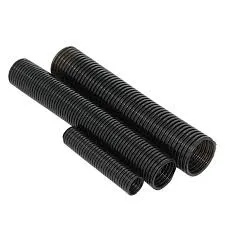corrugated pvc conduit
Understanding Corrugated PVC Conduit Key Features and Applications
Corrugated PVC conduit has become an increasingly popular choice for electrical installations, owing to its versatility, durability, and ease of use. This type of conduit offers a lightweight yet robust solution for protecting electrical wiring from environmental factors, mechanical damage, and various other hazards. In this article, we will explore the characteristics of corrugated PVC conduit, its benefits, and its applications in various sectors.
What is Corrugated PVC Conduit?
Corrugated PVC conduit is a type of non-metallic piping made from polyvinyl chloride (PVC) that features an external corrugated texture. This design provides flexibility, making it easier to install in tight spaces and around obstacles compared to rigid conduits. The inner surface is smooth, allowing for easy pulling of electrical wires. The conduit is available in various diameters, offering options for various applications and wiring requirements.
Key Features and Benefits
1. Durability and Resistance Corrugated PVC conduits are highly resistant to corrosion, impact, and chemicals. This durability ensures that they can withstand harsh environmental conditions, making them ideal for both indoor and outdoor applications. Additionally, the conduits are UV resistant, preventing degradation when exposed to sunlight over time.
2. Lightweight and Flexible One of the standout features of corrugated PVC conduit is its lightweight nature. This makes transportation and installation straightforward, reducing labor costs and time on construction sites. The flexibility of the conduit allows it to be bent and shaped around corners and obstacles, providing a level of convenience that rigid conduits cannot offer.
3. Cost-Effectiveness Corrugated PVC conduits are often more affordable than their metal counterparts. Their lower initial costs coupled with their longevity and the reduced need for maintenance make them an economical choice in the long run.
4. Ease of Installation The installation of corrugated PVC conduits requires minimal tools and special skills. They can be cut easily to accommodate required lengths and are connected using various fittings—including couplings, connectors, and bends—that are designed to work seamlessly with the conduit.
corrugated pvc conduit

5. Safety Corrugated PVC is non-conductive, meaning it poses no risk of electrical shock. This characteristic is especially appealing in environments where contact with water or moisture is likely, as it enhances overall safety for installations.
Applications of Corrugated PVC Conduit
Corrugated PVC conduits are widely used in various fields including
- Residential Wiring Homeowners and electricians frequently use corrugated PVC conduits to protect electrical wiring in walls, ceilings, and outdoor installations. Its flexibility allows for neat and discreet installations.
- Commercial and Industrial Settings Many businesses utilize corrugated PVC conduit for wiring in commercial buildings, factories, and warehouses. Its resistance to chemicals makes it suitable for settings that may encounter harsh substances.
- Telecommunications The conduit is often employed in telecommunication installations to protect cables from damage and weather conditions, ensuring reliable performance.
- Infrastructure Projects For infrastructure development, such as highways and bridges, corrugated PVC conduits are essential for running electrical and communication lines securely and efficiently.
In conclusion, corrugated PVC conduit presents numerous advantages that make it a preferred choice for protecting electrical wiring across various applications. Its combination of durability, flexibility, cost-effectiveness, and ease of installation makes it an indispensable component in the electrical industry. Whether for residential, commercial, or industrial use, corrugated PVC conduits are set to play a vital role in modern electrical installations.








